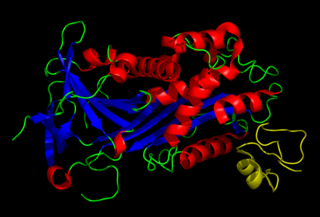
Chromosome 16 is one of the 23 pairs of chromosomes in humans. People normally have two copies of this chromosome. Chromosome 16 spans about 90 million base pairs and represents just under 3% of the total DNA in cells.

Vitronectin is a glycoprotein of the hemopexin family which is synthesized and excreted by the liver, and abundantly found in serum, the extracellular matrix and bone. In humans it is encoded by the VTN gene.

In molecular biology, the Whey acidic proteins (WAP) have been identified as a major whey protein family in milk, and are important in regulating the proliferation of mammary epithelial cells. Additionally, their physiological function is thought to be similar to a protease inhibitor. It has been concluded, therefore, that WAP regulate the proliferation of mammary epithelial cells by preventing elastase-type serine proteases from carrying out laminin degradation and by suppressing the MAP kinase signal pathway in the cell cycle.

AT-rich interactive domain-containing protein 3B is a protein that in humans is encoded by the ARID3B gene.

WAP four-disulfide core domain protein 2 - also known as Human Epididymis Protein 4 (HE4) - is a protein that in humans is encoded by the WFDC2 gene.

Keratin, type II cytoskeletal 78 is a protein that in humans is encoded by the KRT78 gene.

WAP four-disulfide core domain protein 5 is a protein that in humans is encoded by the WFDC5 gene.

Eppin is a protein that in humans is encoded by the SPINLW1 gene.

WAP four-disulfide core domain protein 1 is a protein that in humans is encoded by the WFDC1 gene.

CatSper2, is a protein which in humans is encoded by the CATSPER2 gene. CatSper2 is a member of the cation channels of sperm family of protein. The four proteins in this family together form a Ca2+-permeant ion channel specific essential for the correct function of sperm cells.

Keratin 79 also known as KRT79 is a protein which humans is encoded by the KRT79 gene.

UDP-glucuronosyltransferase 1-8 is an enzyme that in humans is encoded by the UGT1A8 gene.

Inositol monophosphatase 3 also known as inositol monophosphatase domain-containing protein 1 (IMPAD1) is an enzyme that in humans is encoded by the IMPAD1 gene.
WAP four-disulfide core domain 15A is a protein that in the mouse is encoded by the Wfdc15a gene.

Left-right determination factor 2 is a protein that in humans is encoded by the LEFTY2 gene.

Transmembrane protein 255A is a protein that is encoded by the TMEM255A gene. TMEM255A is often referred to as family with sequence similarity 70, member A (FAM70A). The TMEM255A protein is transmembrane and is predicted to be located the nuclear envelope of eukaryote organisms.

Dual specificity phosphatase 8 is a protein that in humans is encoded by the DUSP8 gene.

Protein disulfide isomerase family A member 2 is a protein that in humans is encoded by the PDIA2 gene.

Olfactory receptor family 1 subfamily E member 3 (gene/pseudogene) is a protein that in humans is encoded by the OR1E3 gene.

Otoconin is a structural glycoprotein found in the otoconial membrane of vertebrates. It is the major protein component of the otoconia.














